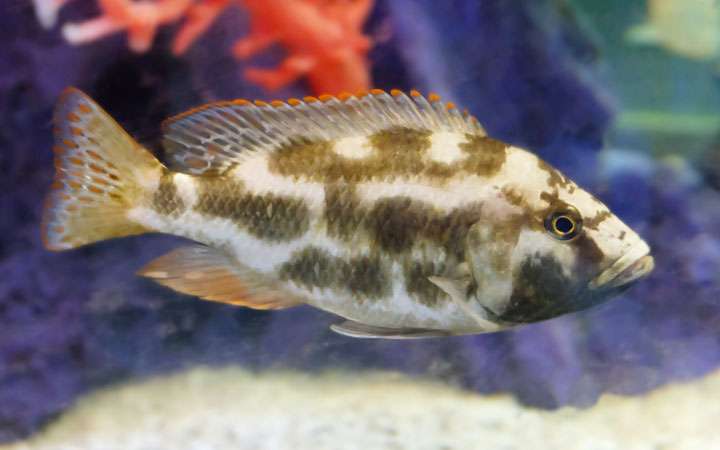
Size
In the wild, males can reach a maximum length of 25 centimeters (9.8 in), but females can only reach 20 cm (7.9 in).
Physical Characteristics and Behavior
Coloration varies, but is typically brown and white with white flecks. The typical orange-to-red band and the sporadic white line may still be evident on the dorsal fin, which can also be blue. In reaction to changed environmental conditions, males of reproductive age frequently “color up,” quickly transforming from splotchy camouflage to brilliant blues and greens, and occasionally even a subtle golden tone. The breeding males’ blotched pattern is almost completely concealed by their dark blue color. The anal fin frequently has an orange-to-crimson tint. Women and men have similar appearances. However, the golden “egg spot” patterns on the anal fin are frequently absent in females. The dots on a juvenile’s coat are brown and white. Given that it is intended to resemble a dead fish, this species’ distinctive color is thought to be a hunting adaptation.
Keeping as Pet

- Water Conditions
They can be found in a variety of settings, ranging from the borders of little lakes to depths of 374 feet (114 m). They frequently vegetated protected bays, particularly ones with Vallisneria plants. The ideal range for temperature and pH is 77 to 81 degrees Fahrenheit and 8.0 to 8.5.
- Tank Size
If they are not breeding, feed them 5 to 6 times a week as adults and once daily when they are young. Avoid the urge to feed this fish more frequently than necessary because doing so will help to maintain greater water quality for a longer period of time.
- Substrate
Sandier surfaces are excellent for fostering the growth of Livingstonii cichlids. Sand made of aragonite and crushed coral are both excellent choices. They dissolve more quickly than salt and aid in maintaining carbonate hardness. The pH level of the tank will also be kept higher by utilizing saltwater sand. However, the likelihood of ammonia accumulation increases with greater pH. Therefore, take care to perform frequent water changes. These fish enjoy spending time on the substrate where they may bury themselves. Therefore, it is preferable to stay away from coarse substrates and big gravels.
- Tank mates
Livingstonii cichlids should only be kept in tanks with fish of the same size that are capable of defending themselves in conflicts. They are also known to get along well with people of their own kind.
The following fish are suitable aquarium mates for livingstonii cichlids: Malawi Peacocks, Victorian Haps, Synodontis, Malawi Haps, Lethrinops sp. Mbasi, Blue Dragon Blood, Sunshine Peacock and along with this, additional big nimbochromis or haplochromis species, as well as species from the Great Rift Valley Lake, could be good prospects.
- Diet
Diet Livingstonii cichlids are omnivores, although because of their predatory abilities, they prefer to eat tiny fish as snacks in the wild. So, it is safe to refer to them as piscivores. They mostly consume lethrinops, a tiny fish, in their natural habitat. They thrive in captivity when fed a diet high in protein. Both live and frozen options are available. The following are some foods you can offer: Carnivore pellets, Aquatic insects, Tubifex worms, Earthworms, Brine shrimp, Insect larvae, Ghost shrimp, Mysis, Feeder fish, Dried krill and Blanched vegetables like zucchini and lettuce.
Table





